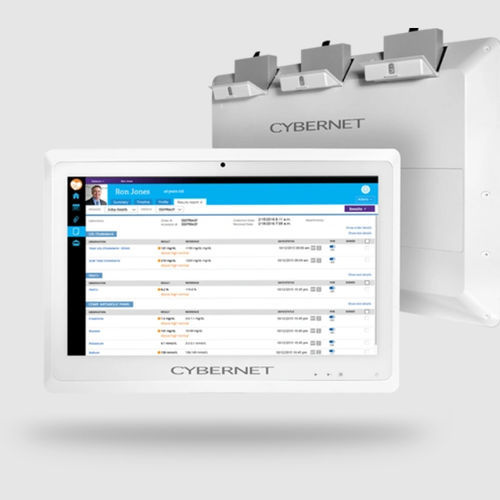
#Industry News
Healthcare Interoperability: Your Essential Guide
What is interoperability in healthcare? Find out here.
Healthcare Interoperability: Your Essential Guide
More healthcare groups than ever have embraced digital technology solutions for their business. Electronic health records (EHRs) have become a ubiquitous part of operations at hospitals around the world, and telemedicine, remote surgery, and more are becoming increasingly common as well.
However, these new information technology forms require new communication and collaboration. For any healthcare organization, interoperability must be a critical priority. Otherwise, organizations can struggle with the tools meant to simplify their work and improve the patient care experience.
What is Interoperability in Healthcare?
Interoperability is more than just a fancy way to say "communication," although that's certainly a major component. A crucial part of interoperability is that all parties involved can edit and update data shared between them.
This requires:
A standardized system for making updates
Standardized language describing a patient’s condition
Data formats all parties can utilize – and much more
Interoperability is the collection of systems and practices that streamline healthcare and deliver a better patient care experience.
For example, let’s say that a patient needs to be transferred from one hospital to another for more specialized care. With interoperability, both hospitals use the same EHR system to share information about the patient’s condition, health history, previous treatments, and more. This enables healthcare providers at the second hospital to integrate the patient into their schedules seamlessly and develop a treatment plan.
Types of Interoperability in Healthcare
Multiple interoperable systems exist, ranging from the language healthcare providers use to communicate with each other to the way data is stored and shared. Organizations must embrace interoperability at all these levels to reap the most significant benefits.
Foundational (Technical)
Healthcare organizations must handle multiple administrative tasks, such as billing, medication management, and documentation. These systems must be able to communicate with each other within the organization and with any external entities.
To simplify this communication, international organizations like Health Level 7 (HL7) implement standards and guidelines for health systems. Standards such as the Fast Healthcare Interoperability Resource (FHIR) provide an internationally recognized basis for exchanging patient data, giving organizations in the healthcare sector a baseline for communicating with one another.
Integrating EHRs and application programming interfaces (APIs) is also critical to interoperability. EHRs are a natural fit for interoperability, given that they can be wirelessly transmitted from one computer to another instantly, allowing healthcare providers worldwide to work off the same information.
Meanwhile, APIs are needed for computers to communicate with each other in this same manner, sharing information across their programs quickly and efficiently with a minimum of human oversight.
Lastly, healthcare organizations need powerful, reliable computers that can run EHR programs and withstand the rigors of a medical environment. Only medical-grade computers that have been independently certified should be considered for this role. Consumer-grade PCs lack the safety and reliability features needed for the healthcare sector.
Structural
One of the most frequent errors committed with data is the creation of a data silo. A data silo is a repository of information that is difficult for other groups to access or edit. A patient's pharmaceutical records stored on a separate server or in a different format from the rest of their information is an example of a data silo.
Data silos impede interoperability in healthcare and keep providers from having a complete understanding of their patients. Healthcare organizations must prevent silos from forming to ensure smooth data flow, both internally and with external entities.
Secure data exchange protocols are another critical concern for interoperability. The healthcare industry is one of the most frequent targets for cybercrime, as EHRs contain a wealth of personal data for criminals to steal.
It is critical for healthcare groups to have secure and standardized communication methods within their organization and with outsiders. Imprivata-based encryption, for example, can protect patient data from prying eyes and ensure that even if a message is intercepted, it is useless to cybercriminals.
Semantic
Interoperability is impossible if providers use different terms for the same condition, or vice versa. Therefore, adhering to a shared and standardized language is critical.
For example, SNOMED CT is an internationally recognized medical term collection that provides codes and definitions for clinical documentation and reporting. By adhering to SNOMED CT, providers at different organizations don’t have to worry about misinterpreting the clinical information their colleagues provide.
The same concept applies to data and frequently takes the form of data mapping. Data mapping is the process of transferring information from one model to the other, typically EHRs. With efficient data mapping, providers save time that they would have to spend on transferring it from one entry to another.
Organizational
organizational interoperability refers to different healthcare entities collaborating effectively. This usually means outside consultation or accepting patients who need more specialized care. Doing so means that patients get the best care possible from the most capable providers.
Data sharing is another critical example of interoperability at the organizational level. All of the prior aspects of interoperability mean nothing if data is not being transmitted between healthcare organizations in the first place.
It’s not just healthcare organizations that stand to benefit from sharing data. Other sectors, such as housing, education, and criminal justice, can also benefit from receiving personal health data (with provisions made for patient privacy).
During a pandemic, governments must be informed of how many citizens are infected and where the hot spots for infection are so that they can assign resources effectively.
Importance and Advantages
Healthcare organizations can enjoy numerous benefits from implementing interoperability.
Enhanced patient care. By utilizing EHRs, healthcare providers have real-time access to a patient’s medical history, enabling them to deliver more accurate and helpful care. EHRs are also available on multiple platforms simultaneously, making coordinating care among various providers easier than relying on a single set of printed papers.
By having a consistent source of seamlessly updated information, providers also have a lower chance of making medical errors.
Increased efficiency and cost-effectiveness. By implementing EHRs and data sharing, healthcare organizations reduce the need for administrative staff, saving money on payroll costs. EHRs also minimize administrative tasks, allowing healthcare providers to spend more time on what truly matters: treating patients.
Additionally, EHRs lessen the need for duplicate testing, saving time, money, and stress for all parties involved.
Enabling data-driven decision-making. With data from patients at their fingertips, healthcare organizations can enable large-scale population health management. This makes it easier to identify environmental factors affecting the community, analyze the health concerns of different demographics, and discover other insights that require large amounts of data.
Without the data that interoperability offers, organizations would have to rely on expensive and time-consuming polling or dig through public records for a better understanding of public health.
Challenges of Establishing Interoperability
As with any change, there are challenges to implementing interoperability in healthcare operations. Data security, differences in standards and terminology, and a lack of funding are all concerns that must be addressed. Fortunately, they CAN be addressed.
Data privacy and security concerns. As mentioned previously, cybersecurity is a serious issue in healthcare IT. In addition to protecting from outside intrusion, healthcare organizations must also ensure the privacy of their patients to remain compliant with HIPAA regulations.
Organizations must also get consent from their patients to utilize their data or share it with other entities.
Fragmented healthcare IT systems. A significant problem for interoperability between different organizations and departments is the use of outdated legacy systems or proprietary EHRs.
While proprietary systems designed specifically for that organization are convenient for internal usage, they make collaboration with external entities incredibly difficult, as they do not have the technology or training to utilize them properly. This forces these entities to waste time transcribing information into their EHR system.
Inconsistent standards and terminologies. One of the most significant roadblocks to interoperability is healthcare organizations using inefficient communication, like different standards and terminologies, to describe the same conditions or issues. The differences lead to misunderstandings, miscommunication, and potentially healthcare errors.
Financial and resource constraints. The inescapable problem is that implementing new EHR systems and training costs both time and money. Staff must be trained to properly use new tools or resources, which takes time away from treating patients.
Additionally, new software needed to manage EHRs might not be compatible with older computers, forcing healthcare organizations to upgrade those as well.
How to Adopt and Streamline Interoperability
While integrating interoperability is a challenge, there are ways to reduce that challenge. Here are a few solutions and strategies to make the process easier.
Adopting international standards. As mentioned earlier, adopting standards like those developed by HL7 makes it far easier to communicate, both internally and with other organizations. DICOM (Digital Imaging and Communications in Medicine) for medical imaging is a similar standard used for storing and transmitting medical images.
Both provide an easy-to-use solution for communications and collaboration used by many other organizations.
Health information exchanges. Health information exchanges, or HIEs, are agreements between different healthcare organizations to share information between them seamlessly. These information exchanges enable organizations to treat patients more effectively, even if they aren’t at their normal site for care.
California’s statewide HIE is an excellent example of this system, coordinating care for 40 million people living in 58 different counties and replacing older, fragmented data exchanges.
Patient matching and identity management. A quick and easy method for linking a patient’s health data across multiple systems is by using identity matching. A healthcare organization can collate multiple medical records into one patient file by corroborating demographic information such as name, birth date, phone number, and address.
Data governance and quality: With the exponential increase in electronic data used in healthcare comes an exponential need for data governance. Having dedicated IT professionals focused on data governance and quality management helps ensure patient data remains accurate, safe, and stored correctly. They can also prevent data silos from forming and ensure cooperation between various departments in the healthcare group.
Collaboration among stakeholders. The most important thing for ensuring interoperability is encouraging a culture of trust and cooperation between stakeholders. This mentality must exist at every level of the healthcare sector, from providers administering care to departments within an organization to organizations working with each other.
By working together, stakeholders can identify pain points within the healthcare industry more efficiently and develop plans for addressing them.
Cybernet: Paving the Way for Healthcare Interoperability
By embracing interoperability as a pillar of their approach to healthcare, organizations in the sector will be better poised to treat their patients and take advantage of new technological advances.
While there are challenges to overcome in updating an organization’s procedures and technology, the benefits of better patient care and lessened administrative load are too good to ignore.
If your healthcare organization wants to integrate interoperability into its structure, consider Cybernet Manufacturing’s range of specialized medical-grade computers and tablets.
Our computers are designed and certified specifically for medical environments. They integrate numerous features that make them perfect for interoperability, such as RFID readers, barcode scanners, and compatibility with modern and legacy equipment.
Contact our experts today, and we can help you select the right medical computer for your organization’s needs.
Join the conversation and connect with us on this and other relevant topics. Follow us on Facebook, Twitter, and LinkedIn.





